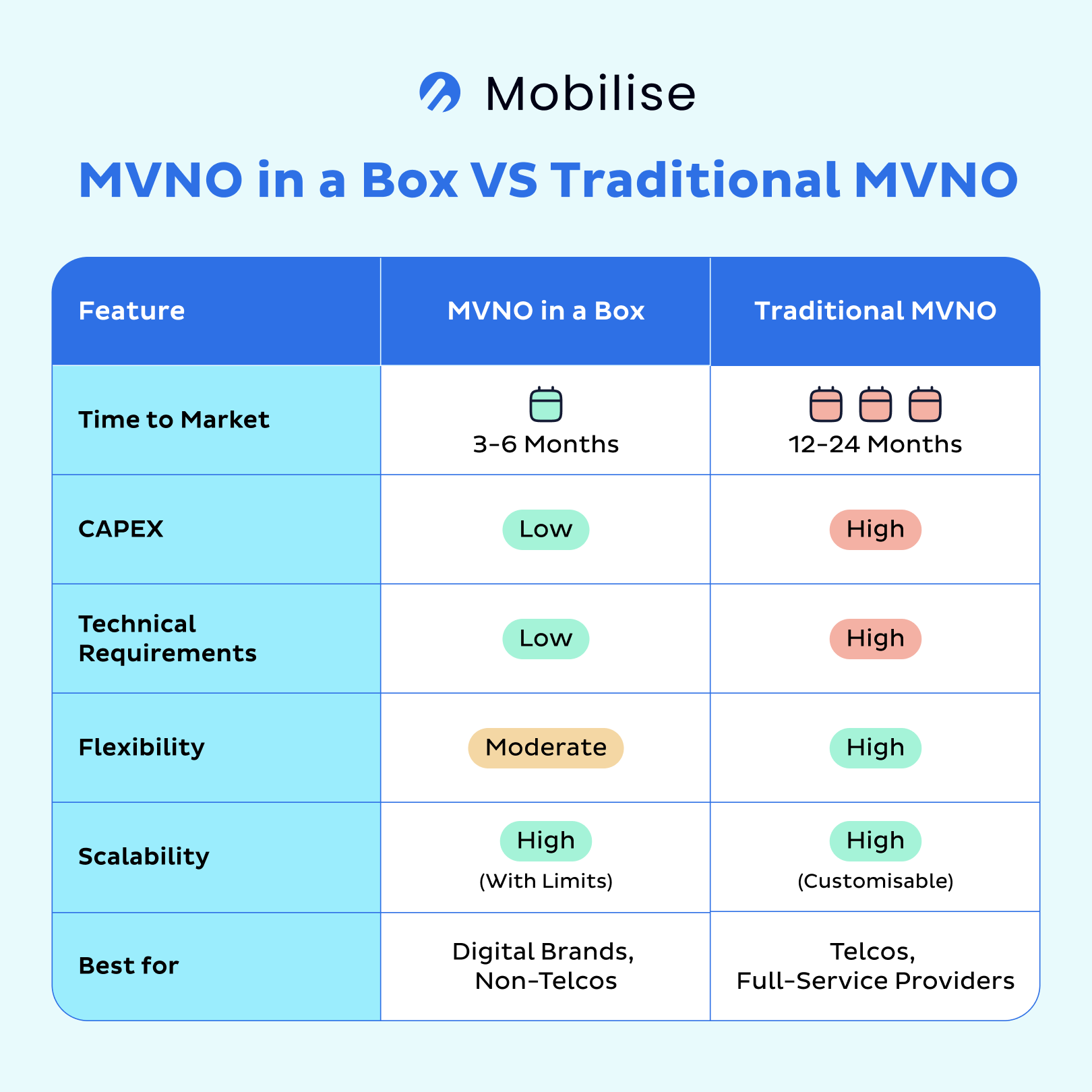As mobile becomes the new frontier for fintech, retail, and travel brands, launching an MVNO (Mobile Virtual Network Operator) is no longer just for telecom giants. But what’s the smartest way in? With mobile connectivity now essential to digital services across industries, many brands are considering entering the telecom space. But before diving in, every new MVNO faces a crucial decision: build a full-stack solution from the ground up or opt for a faster, cost-effective turnkey approach like MVNO in a Box.
In this article, we explore the MVNO in a Box model, drawing from interviews with industry consultants and operators who’ve launched successful MVNOs.
TL;DR
MVNO in a Box is a turnkey solution for launching mobile services without building telecom infrastructure from scratch.
Ideal for fintech, retail, travel, and other digital-first brands looking to integrate connectivity.
Enables a faster time to market – launch in as little as 6 months compared to 1–2 years for traditional MVNOs.
Reduces CAPEX and OPEX with shared infrastructure, predictable costs, and managed services.
Minimises technical complexity, requiring no in-house telecom expertise.
Built for scalability and flexibility, allowing easy expansion and service innovation.
Perfect for brands focused on customer experience and growth, not telecom operations.
What is MVNO in a Box?
MVNO in a Box is a pre-integrated, ready-to-launch solution that gives businesses all the tools needed to become a mobile operator, without building everything from scratch. It includes core components like customer relationship management (CRM), billing systems, user and SIM management, digital onboarding, eSIM-ready apps, and analytics.
This plug-and-play model is fully managed and typically hosted by an MVNE (Mobile Virtual Network Enabler), making it ideal for digital-first brands, fintech companies, travel services, and retailers seeking to integrate connectivity into their offerings.
Rather than spending years negotiating with host MNOs and building infrastructure, MVNO in a Box allows companies to launch and scale in a fraction of the time.
Explore Mobilise's MVNO in a Box Solution
Time to Market: Getting Launched Faster
One of the most significant advantages of MVNO in a Box is speed.
“With a traditional MVNO, you’re looking at 1 to 2 years from idea to launch,” explained Paul Wade, a Senior Consultant at Mobilise. “With a packaged solution, you can be live in as little as 6 months – or even faster.”
Fast time to market is especially important when launching into niche or competitive markets. As one expert put it:
“Timing is everything. If you miss your window, you may never get traction.”
Cost Comparison: CAPEX, OPEX, and Hidden Expenses
Traditional MVNOs require significant upfront investment in infrastructure, staff, customer care, and compliance. Costs can skyrocket before you even sign your first customer.
The main cost centres were staffing, marketing, and customer care setup. If you go full-stack, expect heavy CAPEX and long timelines.
Paul Wade, Senior Consultant at Mobilise
MVNO in a Box dramatically reduces both capital expenditure and operational costs by offering shared infrastructure and support services. Consultants noted that many new entrants underestimate infrastructure costs in the traditional model, while MVNO in a Box helps minimise financial risk, especially for digital-first players.
“If the MVNO is prepared to trade off flexibility for cost, the savings are substantial,” noted one industry consultant.
Launching a traditional MVNO involves substantial capital expenditure (CAPEX) upfront. This includes investments in network infrastructure, software development, licensing, regulatory compliance, and integration with host Mobile Network Operator (MNO) systems. These initial costs can easily spiral, especially when custom-built solutions are required for billing platforms, CRM systems, or operational support.
But the financial burden doesn’t stop there. Traditional MVNOs also face high operational expenditure (OPEX), with ongoing costs such as infrastructure maintenance, software licences, support teams, customer service, and network management. These expenses are often underestimated by new entrants.
Many MVNO startups often fail to recognise hidden expenses, including compliance fees, unforeseen integration issues, and ongoing platform upkeep.
Hamish White, CEO of Mobilise
This lack of cost visibility can create financial risk and strain budgets before an MVNO even reaches the market.
By contrast, MVNO in a Box offers a much more predictable financial path. It eliminates the need for heavy upfront CAPEX by providing pre-built, cloud-hosted infrastructure and services. Operational expenses are consolidated into a clear monthly fee structure that includes essential components like billing, integration, technical maintenance, and compliance management.
With MVNO in a Box, financial planning becomes simpler and more transparent. Startups and digital brands can allocate resources more effectively, avoiding the risk of overspending on infrastructure and instead focusing their investment on growth areas, such as marketing and customer acquisition.
Ultimately, for brands entering the telecom space with limited resources or non-technical backgrounds, MVNO in a Box dramatically lowers the financial barrier to entry while still providing enterprise-grade capability.
Technical Complexity & Resource Requirements
Setting up a traditional MVNO is a technically intensive process. It demands not only a deep understanding of mobile telecommunications but also the ability to manage complex integrations, real-time network operations, regulatory compliance, and customer-facing systems, such as billing and support. This typically requires assembling a specialised in-house team, including telecom engineers, IT developers, and operations staff, often making it impractical for companies without prior experience in the sector.
For most businesses, especially non-telco players, this level of technical demand creates a significant barrier to entry.
“Traditional MVNOs need extensive telecom expertise and operational oversight,” says Hamish White.
A white label MVNO significantly lowers the entry barrier. Brands can engage in the telecom sector without significant investment in internal telecom resources, allowing them to concentrate on attracting customers and marketing.
Hamish White, CEO of Mobilise
MVNO in a Box changes the game by removing much of the technical complexity. These turnkey solutions come pre-integrated with essential systems, including billing engines, CRM platforms, eSIM and SIM provisioning, user management, and regulatory compliance tools, enabling businesses to launch without building these systems themselves.
This is particularly beneficial for industries such as retail, fintech, and digital services, where the goal is to enhance an existing customer offering rather than becoming a traditional telecom operator. With MVNO in a Box, companies can go to market with a telecom product while focusing their resources on differentiation, branding, and user experience, rather than infrastructure and network management.
In short, MVNO in a Box empowers brands to enter the telecom space without needing to become telecom companies.
Scalability & Long-Term Flexibility
Scalability is a critical factor in the long-term success of any MVNO. However, traditional MVNO setups, especially those built on legacy infrastructure, often struggle to keep pace as subscriber numbers grow and service expectations evolve. These architectures can quickly become bottlenecks, with hard-coded systems and manual processes making it costly and time-consuming to introduce new features, respond to market shifts, or support innovation. In many cases, significant re-architecting is required just to maintain service continuity under growing demand.
For new or rapidly expanding MVNOs, this can hinder momentum and impact customer experience.
In contrast, MVNO in a Box is built from the ground up for scalability and adaptability. Designed using cloud-native technologies and modular components, these solutions allow businesses to scale users, services, and geographies without overhauling their core systems.
MVNO in a Box is designed for scalability and long-term viability. Brands can effortlessly grow their service offerings, automate workflows, and incorporate new features without having to overhaul their entire technology stack.
Hamish White, CEO of Mobilise
This flexibility enables MVNOs to adapt quickly, whether by launching new pricing models, bundling additional digital services, or expanding into new markets. Automation and platform integration also reduce the operational burden, allowing teams to focus on customer growth rather than back-end maintenance.
For digital-first brands, this means being able to innovate on the front end while relying on a stable, scalable back end. MVNO in a Box not only lowers the initial barrier to entry but ensures that the solution can evolve alongside the business, supporting long-term growth without sacrificing performance or agility.
Use Cases and Real-World Scenarios
The right MVNO model depends largely on your organisation’s resources, goals, and technical capabilities. Both traditional and MVNO in a Box models have distinct advantages, but they serve very different types of businesses.
Traditional MVNO Setup
Traditional MVNOs are best suited for large telecom operators or companies with significant in-house infrastructure and telecom expertise. These organisations typically have the resources and technical capacity to build and manage full-stack solutions. They often pursue this model to maintain full control over network integrations, service innovation, and custom product offerings. Well-known examples include Tesco Mobile and Lyca Mobile, both of which operate on a scale that justifies the high CAPEX and operational complexity.
MVNO in a Box
MVNO in a Box, by contrast, is tailored for digital-first businesses that want to quickly enter the mobile space without the burden of telecom infrastructure. Who is MVNO in a Box for?
- Fintech: Add connectivity to your digital wallet for seamless travel benefits
- Retail: Embed mobile services into loyalty programmes
- Travel: Offer roaming bundles inside your app
- Startups: Launch new digital brands without telecom baggage
- Enterprises: Open new revenue streams with mobile
Examples of companies successfully leveraging this model include Revolut, NuBank, and Wizz Air, all of which have integrated telecom offerings into their existing ecosystems using digital-first, hosted platforms.
For businesses without a telecom background or those looking to embed connectivity into broader digital services, MVNO in a Box offers a low-risk, high-reward route to market.
How to Choose the Right Model: MVNO in a Box vs. Traditional MVNO
When deciding between traditional and turnkey models, experts agree it comes down to your business strategy.
“If you need speed, lower cost, and simplicity – MVNO in a Box is the right fit.”
“But if you’re building a highly customised or bundled proposition, traditional models may offer the flexibility you need.”
Here’s a quick comparison:

Conclusion
The insights make one thing clear: MVNO in a Box is a game-changer for digital-first businesses. It shortens time to market, lowers upfront investment, reduces complexity, and supports scalable growth.
For non-telecom brands or new market entrants, the simplicity of a white label, fully managed solution enables you to focus on what matters most: creating standout customer experiences and winning market share.
Want to launch an MVNO the smart way? Contact Mobilise or Explore MVNO in a Box today to get started.



